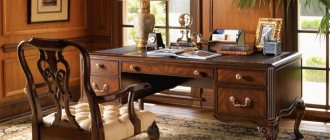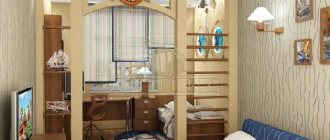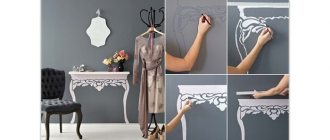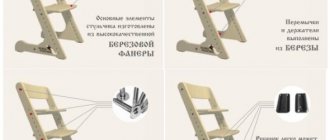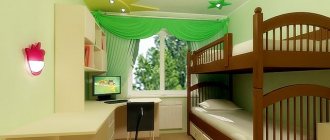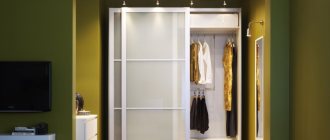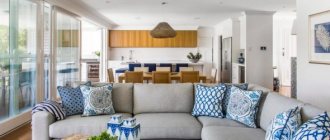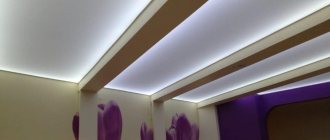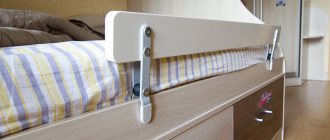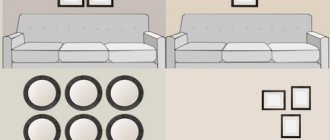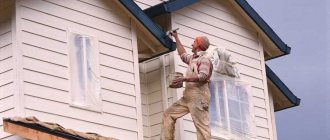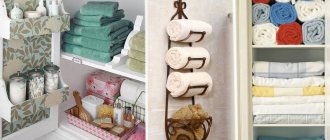So, what to buy and where to set up a workplace?
You shouldn’t put a schoolchild’s desk...
- In the kitchen. Even if it is roomy, it is not the best option. Firstly, the kitchen is a place not only for cooking, but also for constant gatherings, meetings, tea parties, clarifying problems and questions, etc. The child simply will not be able to concentrate on studying. Secondly, cuisine is food with which textbooks are completely incompatible.
- At the door. We reject this option immediately. You can’t do homework either at the door or with your back to the door. This arrangement provides psychological discomfort for the child.
- Under the 2-tier bed. Of course, you will be able to partially save square meters, but the child is guaranteed discomfort. Psychologists do not even recommend sleeping on the lower tiers - “pressure” from above does not bring any benefit. And it will also be difficult to help a child with his homework - there will be even less space for an adult.
- In the center of the room against the wall. This is a great option for mom and dad. You can immediately see what the child is doing. But for the baby himself, the option is not particularly attractive. Just like an adult, a child is much more comfortable in a private corner, where there is no need to hide notebooks from prying eyes. Personal space should be at least a little secluded.
Play and work areas in the student’s workplace
Psychologists recommend separating study and play areas. And although play is the leading activity for a first-grader, agree with your child that there is no place for toys in the learning area. Favorite cars, dolls and construction sets will move to the play area so as not to distract the child.
However, you should not go to the other extreme and remove all the usual games and toys from the room of a newly minted student, because serious life begins. First grade is stressful, and familiar things help a child cope with it.
If it is difficult for a child to cope with the separation of work and play areas, you can agree that one favorite bear will help him do his homework, sitting next to a lamp or on a shelf.
And intellectual board games have a place in the learning area. And it's not just checkers or chess. There are many board games out there these days, from strategy games like Carcassonne to math games and vocabulary games. Of course, the parent will have to be actively involved in all this intellectual entertainment. On a tablet, the child kills monsters alone, but board games require company.
So where should you put the table?
We choose a place based on the main conditions:
- There should be a wall behind the child's back.
- The child should immediately see everyone entering the room. Or at least when turning your head to the left (right). That is, the child should not look back to see the person entering.
- A little privacy. We create it either with the help of furniture or through a separate room. You can fence off the table with a bookcase, install it on an insulated loggia, set aside a separate cozy place in the bedroom, etc.
- A table by the window is a great option. But only if there are curtains or the ability to install the table a little to the left or right of the window, so that the bright daylight does not blind the eyes and the glare on the monitor does not interfere.
- Daylighting is a must! Is the child right-handed? This means the light should come from the left. And if you're left-handed, it's the other way around.
- Away from the TV! So that the child is not distracted from lessons and does not “squint” (this spoils vision). And away from TV radiation (safe distance - from 2 m).
LiveInternetLiveInternet
1. We all want to make the lives of our children bright and carefree, but at the same time we often proceed not from the real needs of the child, but from our own opinions and preferences. Therefore, when choosing furniture for a schoolchild, first consult with your child. And now some examples and interesting solutions for a schoolchild’s workplace.
2. -The table cannot be placed opposite the window. Everyone knows that light should only come from the left. You can place the light source on the left and behind, but in no case on the right - then the table will be completely darkened. A table facing a window is not the best solution: the rays of the sun are reflected from its surface, causing your eyes to become tired. If there is no other option, then the table should be at least 15 centimeters away from the window, and ideally half a meter. 3. -Furniture must be selected specifically for the child. To determine whether a chair fits your child, sit him so that his feet are flat on the floor. If the angle between the thigh and lower leg is straight, everything is in order. If the angle is sharp, the chair is too small, if the angle is blunt, it is too big. There is another way: to check the height of the table: the child can place his elbow on the tabletop and raise his head, looking straight ahead. The middle finger should be at the level of the corner of the eye. 4. -A place should be reserved for notebooks and textbooks. If the table has drawers, you can put pencils, pens, notebooks, albums, etc. there. If not, buy a regular bookcase or shelf, which can be open or closed, but less deep than in an “adult” closet. 5. By the way, psychologists say that open shelves promote openness of character. In addition, open shelves “teach” the child to keep things clean, because the mess on them is immediately visible to everyone. 6. -The lamp should not be halogen. If a child does homework in the evening, one table lamp is not enough. There should be no sudden changes in lighting, so turn on both the overhead light and the table lamp, which should be on the left. 7. -The computer should not be placed on a regular table. On a regular desk, as a rule, there is not enough space for a computer, and in this case the distance from the monitor to the child’s eyes is less than the recommended 50-70 centimeters. It is unlikely that there will be many families who can place two tables at once in the children's room, so as a compromise, you can choose a table with an ergonomic tabletop located at an angle. Then the monitor will occupy the very corner of the table and will be, as it should be, at arm’s length. Plus there is plenty of space to write and draw. 8. A board for notes, memos and other useful things that should always be at hand. 9. 10. 11. 12. info: https://shkolazhzni.ru
If you really don't have enough space...
- The table can be made folding (from the wall), but, again, taking into account the possibility of privacy.
- If there are two children , then you can connect their tables with one partition (or a bookcase for textbooks) - both space saving and privacy.
- You can build a table on a long tabletop , designer stretched along the wall above the cabinets. Part of the table top is for household items, part is for the child personally.
- Extended window sill. In tiny apartments this option is often used. The window sill is widened, lengthened, and a high comfortable chair is placed.
- Small corner table. Convenient in small spaces. Additional shelves wouldn't hurt.
- If you have some imagination, the table can be installed anywhere in the common room using space zoning (color, podium, screen, etc.). Zoning the space of a children's room for children of different sexes is an excellent design and convenience.
- Table transformer. This is also a good option, allowing you to expand the work surface and change the height of the legs according to the need.
Decorating your desktop
Custom modular furniture is a lifesaver for parents who understand that organizing a workplace in accordance with the child’s wishes is a confident step towards independent study and development of perseverance. The main requirement for a desk is the height of the child (approximately waist-deep). The feet of a student sitting at his workplace should be on the floor, and his arms, bent at the elbows, should be on the table. If this is a purchase for growth, take care of a chair with height adjustment and a comfortable footrest.
According to European standards, even the size of the tabletop matters (80cm – width; 1.6m – length). It is believed that it is on such a table that the computer will be at the optimal distance from the child’s eyes, and the size of the area will provide a sufficient amount of free space for placing accessories and the child’s creativity.
For limited space, you can select ready-made (or made to order in the required configuration) compact modules that combine several functions: - library - desktop; - play area - desktop; - sleeping place - desk - play area; – sleeping place – desk – sports corner and other combinations
But trust the choice of furniture color and design to your baby. However, you can take a standard model of a computer table or work corner and decorate it yourself with funny stickers or posters with your favorite movie and book characters. To decorate the workplace, you can use whatever your child likes, which will lift his spirits and make his time at home easier and more enjoyable. Soft toys, family photographs, bright stationery, and funny trinkets are suitable for this.
What do experts say on this topic?
- Required space under the table: width - from 50 cm, depth - from 45 cm.
- Working surface space: width - 125-160 cm, depth - from 60-70 cm.
- The edge of the table is at the level of the child's chest. When working at a table, the child’s legs should be at right angles, the baby should lean on the table with his elbows, and his knees should not rest against the tabletop from below.
- If the table is too high , choose a suitable chair.
- The legs need support - they should not dangle in the air. Don't forget the footrest.
- The table material is exclusively environmentally friendly (including the paint and varnish surface).
First-grader desk for home, selection criteria
The formation of posture will depend on the correct choice of desk. There are many models of tables, and you must first decide what it should be like and what functions it should have.
Decide in advance whether the table will have drawers and a built-in cabinet. Determine their number, not forgetting that the student should be comfortable. Particular attention should be paid to the quality of the desk.
You don't have to buy the most expensive one. Typically, children of primary school age are not particularly neat, so buy furniture that can be easily washed off paints, felt-tip pens and plasticine.
As for the size of the table, you should focus on the following parameters:
- Width minimum 50 cm.
- Depth from 65 cm.
- The space for the tabletop is no less than 50x50 cm.
The best option would be a table that has height adjustment. This will help you save some money in the future, which is already spent quite a lot when getting ready for school.
Let your child accompany you in the store when choosing a table. He will definitely try everything on the spot, and it will be easier for you to decide.
Do not buy a table on which you can immediately place a computer, the so-called 2 in 1. The presence of nearby equipment on which you can play will greatly distract from your studies.
It is also worth paying attention to the material from which the furniture is made. Most often we come across furniture made from chipboard. This type of material is quite durable. The price-quality ratio is the most optimal.
There is a cheaper option, laminated chipboard. You should not buy such furniture without a quality certificate; the material is the most hazardous to health.
More expensive and high quality - MDF. Its environmental safety can be compared to natural wood.
Size table:
- With a height of 100-115 cm: table height - 46 cm, chair height - 26 cm.
- With a height of 115-130 cm: table height - 52 cm, chair height - 30 cm.
- With a height of 130 - 145 cm: table height - 58 cm, chair height - 34 cm.
- With a height of 145 - 160 cm: table height - 64 cm, chair height - 38 cm.
- With a height of 160 - 175 cm: table height - 70 cm, chair height - 42 cm.
- If you are over 175 cm tall: table height - 76 cm, chair height - 46 cm.
How to choose the right desk?
When choosing a desk, in my opinion, you should pay special attention to ergonomics. A small child at an adult table risks ruining his posture. If the baby has not yet grown to 120 cm, the table should not be higher than 52 cm. The edge of the table should be a couple of centimeters below the chest level of the sitting child. In such a way that the child can rest his elbows calmly. With a height of 120-150 cm, a table with a height of 52-61 cm is suitable. A child can start using a standard “adult” table with a height of 75 cm when he grows to 150 cm.
Therefore, I would recommend making a table to order. In this case, it is easier for you to choose the color, shape and material of the table. But you can also opt for a specialized transforming table. Firstly, it will constantly grow with the child, and secondly, such tables are suitable for schoolchildren of different ages.
Choosing a chair!
What to buy - a chair or an armchair?
Of course, the chair is much more comfortable: it is adjustable in height and backrest angle, and some models even have footrests.
But the selection criteria, regardless of whether it is a chair or an armchair, will be the same:
- The seat should be comfortable and soft. If it's a chair, use a thin pillow.
- If it is a chair, choose a piece of furniture with orthopedic functions.
- High stability.
- A flat and firm back, against which the child’s back should be pressed tightly (this takes the load off the spine).
- The materials are environmentally friendly. Check the quality certificate!
Is a computer needed on a child's desktop?
Today, elementary schools already practice computer science classes, and already from the 3rd grade, many children even create simple presentations on their own on a PC, but in the first 2 years you definitely won’t need a computer.
Whether or not to install a PC for a child depends on the parents.
But remember that the maximum time for practicing on it at the age of a first-grader is half an hour a day!
If you still decide that your child should have his own computer, then let it be a laptop that can be taken out for a certain time and then put away again.
You should not leave it on the table on a permanent basis - the child will be distracted from studying. The temptation to play another game or check messages on social networks is too great.
How to organize a student’s workplace during distance learning at home
A sedentary position at a desk or desk affects the functioning of many systems of the student’s body, especially the cardiovascular and respiratory. When sitting for a long time, breathing becomes less deep, metabolism decreases, blood stagnates in the lower extremities, which leads to a decrease in the performance of the entire body and especially the brain: attention decreases, memory weakens, coordination of movements is impaired, and the time of mental operations increases.
- It is recommended that the student’s workplace be located near the window for sufficient natural light (for a right-handed child, the table should be placed to the left of the window, for a left-handed child - to the right. Even if there is good overhead lighting and a natural light source (window), a table lamp is needed on the table. For shade do not interfere, the lamp for a right-handed child should be placed on the table on the left, for a left-handed child - on the right.
- If a computer is installed on the student’s desktop, the monitor should be directly in front of the eyes (so that the child does not have to turn towards it). The video monitor screen should be located at a distance of 600 - 700 mm from the user’s eyes.
- It is advisable to place books on a stand at arm's length from your eyes. This allows the child to keep his head straight (relieves the load on the cervical spine) and prevents the development of myopia.
- It is necessary to maintain the correct working posture during training sessions, which is the least tiring: sit deeply in a chair, keep your body and head straight; legs should be bent at the hip and knee joints, feet resting on the floor, forearms resting freely on the table.
- The chair is moved under the table so that when resting on the back, there is a distance between the child’s chest and the table equal to the width of his palm.
- You cannot lean your chest on the edge of the desk (table); the distance from the eyes to the book or notebook should be equal to the length of the forearm from the elbow to the end of the fingers. The hands lie freely, not pressed against the table, the right hand and the fingers of the left rest on the notebook. Both legs rest with their entire feet on the floor.
- If a child writes, he leans on the back of the chair with his lower back; when reading the material, he sits more freely, leaning on the back of the chair not only with the sacro-lumbar part of the back, but also with the subscapular part of the back.
- Furniture must correspond to the height of the child.
To prevent overfatigue, every 30-45 minutes of exercise it is necessary to do physical exercises and eye exercises.
According to SanPiN 2.4.2.2821-10, training sessions that combine mental, static, dynamic loads on individual organs and systems and on the entire body as a whole require physical exercise minutes to relieve local fatigue and the general impact.
Recommended set of exercises for physical education minutes
· Physical education to improve cerebral circulation:
1. Starting position - sitting on a chair. 1-2 - move your head back and smoothly tilt it back, 3-4 - tilt your head forward, do not raise your shoulders. Repeat 4-6 times. The pace is slow.
2. Starting position - sitting, hands on your belt. 1 - turn the head to the right, 2 - Starting position, 3 - turn the head to the left, 4 - Starting position Repeat 6-8 times. The pace is slow.
3. Starting position - standing or sitting, hands on your belt. 1 - swing your left hand over your right shoulder, turn your head to the left, 2 - Starting position, 3-4 - do the same with your right hand. Repeat 4-6 times. The pace is slow.
· Physical education to relieve fatigue from the shoulder girdle and arms:
1. Starting position - standing or sitting, hands on your belt. 1 - right hand forward, left hand up. 2 - change hand positions. Repeat 3-4 times, then relax down and shake your hands, tilt your head forward. The pace is average.
2. Starting position - standing or sitting, with the back of your hands on your belt. 1-2 - bring your elbows forward, tilt your head forward. 3-4 - elbows back, bend over. Repeat 6-8 times, then hands down and shake relaxed. The pace is slow.
3. Starting position - sitting, arms up. 1 - clench your hands into a fist, 2 - unclench your hands. Repeat 6-8 times, then relax your arms down and shake your hands. The pace is average.
· Physical education to relieve body fatigue:
1. Starting position - legs apart, hands behind your head. 1 - sharply turn the pelvis to the right. 2 - sharply turn the pelvis to the left. During turns, leave the shoulder girdle motionless. Repeat 6-8 times. The pace is average.
2. Starting position - legs apart, hands behind your head. 1-5 - circular movements of the pelvis in one direction, 4-6 - the same in the other direction, 7-8 - arms down and shake your hands in a relaxed manner. Repeat 4-6 times. The pace is average.
3. Starting position - legs apart. 1-2 - bend forward, the right hand slides down along the leg, the left hand, bending, moves up along the body, 3-4 - Starting position, 5-8 - the same in the other direction. Repeat 6-8 times. The pace is average.
General physical training sessions include exercises for different muscle groups, taking into account their tension during activity.
A set of exercises for physical education minutes for students of primary general education in lessons with elements of writing:
1. Exercises to improve cerebral circulation. Starting position: sitting, hands on your belt. 1 - turn your head to the right, 2 - Starting position, 3 - turn your head to the left, 4 - Starting position, 5 - smoothly tilt your head back, 6 - Starting position, 7 - tilt your head forward. Repeat 4-6 times. The pace is slow.
2. Exercises to relieve fatigue from the small muscles of the hand. Starting position: sitting, arms raised up. 1 - clench your hands into a fist, 2 - unclench your hands. Repeat 6-8 times, then relax your arms down and shake your hands. The pace is average.
3. Exercise to relieve fatigue in the core muscles. Starting position - legs apart, hands behind your head. 1 - sharply turn the pelvis to the right. 2 - sharply turn the pelvis to the left. During turns, leave the shoulder girdle motionless. Repeat 4-6 times. The pace is average.
4. Exercise to mobilize attention. Starting position: standing, arms along the body. 1 - right hand on the belt, 2 - left hand on the belt, 3 - right hand on the shoulder, 4 - left hand on the shoulder, 5 - right hand up, 6 - left hand up, 7-8 - clapping hands above the head, 9 - put your left hand on your shoulder, 10 - your right hand on your shoulder, 11 - your left hand on your belt, 12 - your right hand on your belt, 13-14 - clap your hands on your hips. Repeat 4-6 times. Tempo: 1 time slow, 2-3 times medium, 4-5 times fast, 6 times slow.
Recommended set of eye gymnastics exercises
1. Blink quickly, close your eyes and sit quietly, slowly counting to 5. Repeat 4-5 times.
2. Close your eyes tightly (count to 3, open them and look into the distance (count to 5). Repeat 4-5 times.
3. Extend your right arm forward. Follow with your eyes, without turning your head, the slow movements of the index finger of your outstretched hand to the left and right, up and down. Repeat 4-5 times.
4. Look at the index finger of your outstretched hand for the count of 1-4, then move your gaze into the distance for the count of 1-6. Repeat 4-5 times.
5. At an average pace, make 3-4 circular movements with your eyes to the right side, and the same amount to the left side. Relax your eye muscles and look into the distance while counting 1-6. Repeat 1-2 times.
Based on materials from Rospotrebnadzor
Main criteria:
- The light should be as close to natural as possible. We choose a lamp with yellow light - an incandescent lamp of 60-80 watts. Don’t skimp on your child’s vision—energy-saving white light bulbs won’t do! Halogen light bulbs are too bright for a baby - they are not worth purchasing.
- Luminescent ones are also not an option - their invisible flicker tires the eyesight.
- In addition to your own lamp, naturally, there must also be general lighting of the room , otherwise the child’s vision will deteriorate very quickly. This could be a chandelier, sconce, or additional lamps.
- Design of a child's table lamp. Basic requirements: minimum elements. The child should not have the desire to disassemble the lamp or play with it. Therefore, lamps in the form of toys are not suitable for first-graders. Various decorative elements in the form of crystal, etc. are also undesirable. They create glare, which negatively affects vision.
- Safety. The lamp must be shockproof. So that the child, while playing, does not accidentally break it and get hurt.
- The lamp must have a lampshade (preferably yellow or green) so that the light does not blind the child.
- It is desirable that the design of the lamp allows you to change its angle , and the base of the lamp is carefully secured to the table using a bracket.
Photo of computer tables in the interior of a children's room
<
>
The choice of a computer desk for a boy and a girl is generally no different. It is important that the model is comfortable and allows you to create a working environment. If you wish, you can experiment with color. Perhaps a young lady will prefer light shades and smooth lines, while young people will prefer rigor and conciseness.
Photos of the best options for a home workplace for a schoolchild
How did you arrange a workplace for your student? Share your tips in the comments below!
Schoolchild's workplace: 20 life hacks for organizing order
In September, children have to get into the rhythm of school, classes and hard work. And only one thing can prevent all this - disorganization and disorder!
Help your child organize his space so that every day he doesn’t have to spend a lot of time looking for notebooks, office supplies and his schedule! And we offer you 20 ideas on how to bring this plan to life!
